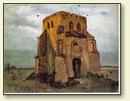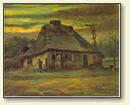| Relevant paintings: 
"Old Cemetery Tower at Nuenen," Vincent van Gogh
[Enlarge]

"Cottage at Nightfall," Vincent van Gogh
[Enlarge]
|
Dear Theo,
Today I sent off the small box in question, containing,
except what I mentioned already, another picture,
“Cimitière de Paysans.”
I have omitted some details - I wanted to express how those
ruins show that for ages the peasants have been laid to
rest in the very fields which they dug up when alive - I wanted
to express what a simple thing death and burial is, just as
simple as the falling of an autumn leaf - just a bit of earth
dug up - a wooden cross. The fields around, where the grass of
the churchyard ends, beyond the little wall, form a last line
against the horizon - like the horizon of the sea.
And now those ruins tell me how a faith and a religion
mouldered away - strongly founded though they were - but how
the life and the death of the peasants remain forever the same,
budding and withering regularly, like the grass and the flowers
growing there in that churchyard.
“Les religions passent, Dieu demeure” [Religions
pass away, God remains], is a saying of Victor Hugo's whom they
also brought to rest recently.
I do not know if either of these two pictures will please
you - the cottage with the mossed roof reminded me of a wren's
nest. Well, just look them over.
I must use this opportunity to explain once more, as I found
new and clear words for it, why I wrote you, and write again,
that I am far from sure that your present opinion is a definite
conviction.
The house of Goupil & co. is not a good training school
for becoming acquainted with pictures, even less so with
painters.
I tell you my opinion is that one does not even learn to
have an independent view. To whom did they pay great honour? To
Paul Delaroche.
I need not tell you that Delaroche was one of those of whom
very little remains; hardly anybody takes his part any
more.
Another one who will not last, though he is
better and once or twice made something very beautiful,
of whom little will remain also --is Gérôme.
But his “Prisoner,” his “Syrian
Shepherds” are real, and I admire them just as
much as anybody, and willingly and readily. But for the most
part he is a second Delaroche, both are of equal value,
considered in the framework of their time. Now what I assert
and think most probable is that the whole situation will bore
you more and more each year. Further, I assert that it is doing
a bad turn to others, and especially to oneself, to let oneself
be bored. In spite of many wise maxims I have never been able
to believe that it may be of any practical use, or for one's
own good, to be bored. A good many people have reformed
themselves at the age of thirty and have changed considerably.
Think this over in all calmness; I tell you that of all I have
learned and heard at Goupil & co.'s about art,
nothing has held true. If one reverses the commonplaces which
count there as the highest wisdom in art matters, namely
applauding the former and present Delaroche style and maligning
the unorthodox modern painters, I repeat, if one
reverses certain sayings - one breathes a purer air. In
short, boy, in circumstances and in business such curious
changes are not only possible but even usual.
It is odd that I doubt whether you will stay in business
after all.
You need not pay attention to this or answer it, I just tell
you it straightway to express my idea, not to open sterile
discussions.
But it exists - that enchanted land - where one is not
free.
Well, I hope to hear soon that you have received the box,
and whether you like the pictures.
Tomorrow I am going to paint a spot in another village, also
a cottage - in a smaller size. I found it last Sunday, on a
long ramble made with a peasant boy to find a wren's nest.
We found six of them, it was a spot that Bodmer certainly
would have loved. And they were all nests which the young birds
had left, so one could take them without too many scruples. It
was so full of character, I have some more beautiful nests.
Goodbye, write soon, with a handshake,
Ever yours, Vincent
I should like you to varnish both pictures before you show
them to Portier or Serret.
Last week the sheep
were shorn, I saw it, it was done on a table in the barn. I am
glad I can show Portier something quite different this
time.
For the rest I am very busy making drawings, in order to
send you some full-size figures before long.
But while I was working on those cottages - perhaps you will
call them imitations of Michel, though they aren't - and
looking for subjects, I found such splendid hovels that I
cannot help painting some more variations of those
“peasants' nests” which remind me so much of the
wren's nest.
Oh, beyond all doubt - whoever paints peasants nowadays and
has his heart in this work will have part of the public on his
side, and not the worst part - though it may not be the
largest. But for all that, the end or second half of the month
will prove very meager for me. But the same happens to the
peasant boys - and yet they enjoy their lives.
I wish you had been with me last Sunday when we took that
long walk. I came home quite covered with mud, for we had had
to wade through a brook for half an hour. But painting becomes
stimulating and exciting to me, like hunting - in fact it
is a hunt for models and beautiful spots.
Once more goodbye, and best wishes. It is already late, and
at five o'clock I must be on duty, so goodbye.
At this time, Vincent was 32 year oldSource:
Vincent van Gogh. Letter to Theo van Gogh. Written early June 1885 in Nuenen. Translated by Mrs. Johanna van Gogh-Bonger, edited by Robert Harrison, number 411.
URL: https://www.webexhibits.org/vangogh/letter/15/411.htm.
This letter may be freely used, in accordance with the terms of this site.
|